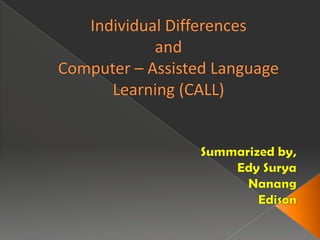
Individual differences
- 1. Individual DifferencesandComputer – Assisted Language Learning (CALL) Summarizedby, Edy Surya Nanang Edison
- 2. Theories of second language learning Individual differences Summary
- 3. Models of Second Language Acquisition (SLA) Models with independent learner variables - The “Good Language Learner’ Model - Monitor theory - Brown & Fraser’s Framework - Levin’s Schematic Model Models with Interdependent learner variables - Gardner’s Educational Model - Skehan’s Model of influences on language learning - Spolsky’s Model of second language learning
- 5. Speaking
- 6. Reading
- 8. Transfer
- 9. SimplificationConscious processes - strategies Age Intelligence Aptitude Motivation Attitude Personality Cognitive Style THE CONTEXT EFL/ESL Opportunities for use Social Milieu
- 11. Motivation
- 12. Self-confidence
- 14. Levin’s Schematic Model 1977 2 major stages : - diagnostic - prescriptive 2 variables : - input (traits, abilities, prerequisites) - output
- 15. Gardner’s Educational Model The model encompasses three main aspects: - Cultural beliefs - Individual differences - Second Language Learning (SLA)/learning contexts There are three points that can be inferred from Gardner’s model. - There should be a direct link between cultural beliefs and individual difference variables - Gardner highlights the importance of individual differences (e.g. intelligence, language aptitude, motivation, and situational anxiety) upon which his approach is primarily based. - There is a linkage between variables within the framework which, in turn jointly affect other variables.
- 16. Models with interdependent learner variables These models not only identify the independent influence of the individual-related variables and other variables but also consider that these variables influence each other and jointly create differences in learning outcomes. Models of this type include: - Gardner’s educational model - Skehan’s model of influences on language learning - Spolsky’s model of second language learning
- 17. Skehan’s Model of Influences on Language Learning A modification of the ‘Good Language Learner (GLL)’ model developed by Naiman, et al, (1978) There are two differences between the two models: 1. A new ‘opportunities for target language use’ category has been added 2. The sub-variables under the ‘classrooms andmaterials’ variable was proposed
- 18. Spolsky’s Model of Second Language Learning Spolsky based his model on a core of five features summarized as follows: - Combining in a single theory all aspects of second or foreign language learning which he described as ‘unabashed immodesty’. - A restriction to the specific domain of second language learning and a focus on individual differences. - ?? - A spirit of eclecticism seems to underlie Spolsky’s model. - The model recognizes the importance and existence of ‘social context’ as an important domain affecting learning outcomes. Spolsky’s model consists of two main clusters, i.e. ‘conditions of social contexts’ and ‘conditions of learners’.
- 19. There are two points that can be noted from Spolsky’s model of language learning and its underlying features: 1. Spolsky’s model appears to be promising as a parameter for identifying variations in learner variables 2. The second point relates to the fourth feature underlying Spolsky’s model. This feature of eclecticism clearly implies that his model can be modified and adjusted according to learning conditions (contexts).
- 20. From the review of these specific SLA models,there are two points that can be highlighted: No matter what the model of SLA is, learner variables are claimed to relate to learning outcomes Most models posit learner variables as caused variables influencing the learning outcome.
- 21. Individual Differences Age Attitudes Motivation Intelligence Language aptitude Previous knowledge Familiarity with computers Interaction with native-speakers of English Language used for interaction with the community
- 22. Age young children are better in the most crucial areas particularly in oral (communicative) proficiency, but adults have rate of acquisition is faster than children, particularly in morphology and syntax
- 23. Attitudes A student who has negative or positive attitude toward learning process will affects his/her interaction during the learning process.
- 24. Motivation Intrinsic Intrinsic motivation is one which comes from the learners’ own persona Extrinsic Extrinsic motivation is one which comes from out side and beyond individual
- 25. Intelligence There is a positive correlation between intelligence and language learning achievement.
- 26. Language Aptitude According to Carrol (1981:84) aptitude can be defined as : a concept which corresponds to the notion that in approaching a particular learning task or program, the individual may be thought of as possessing some current state of capacity of learning that task if the individual is motivated, and has the opportunity of doing so. The capacity is presumed to depend on some combination of more or less enduring characteristic of the individual.
- 27. Previous knowledge In a foreign language learning context, previous language knowledge plays an important role in a further process of language learning, in terms of language learning achievement.
- 28. Familiarity with computers It is considered as a variable in a computer-mediated language learning environment. It will help the students to access the knowledge.
- 29. Interaction with native-speakers of English Interaction with native speakers of the target language being learned can enhanced language learning achievement?
- 30. Language used for interaction with the community Smith-Kreuzen (1988) : learners will interact using the target language. Hartoyo : only in formal-teaching learning situations (classroom context). In informal situations (outside the classroom), Indonesian is likely to be used more than English.
- 31. SUMMARY Despite the fact that not all studies on the relationship between individual-related variable and language learning achievement have revealed similar findings, the majority of studies indicates that these variables significantly affect language learning achievement. Furthermore, the review has repeatedly demonstrated that the variables do not operate in isolation. There are important though unclear interactions between them. However, this general agreement still requires further empirical study if we want to investigate a particular variable in a particular context.